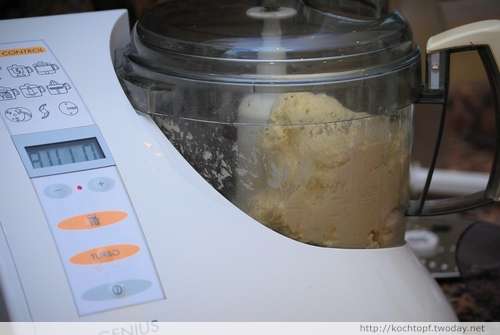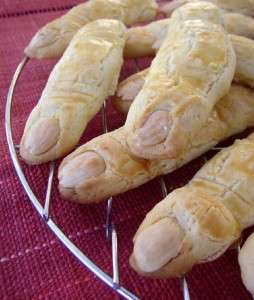Holly cow, I realized only yeasterday that today is the revealing date for this month Daring Bakers‘ challenge!
The September 2009 Daring Bakers‘ challenge was hosted by Steph of A Whisk and a Spoon. She chose the French treat, Vols-au-Vent based on the Puff Pastry recipe by Michel Richard from the cookbook Baking With Julia by Dorie Greenspan.
If you ever have made puff pastry, you know that it’s not made in 5 minutes. :-(
I love puff pastry and I wanted to this dough since a long time, so I started immediately with the dough…
… as followed:
Puff Pastry
500 g flour
300 g ice water (mine came out of the fridge)
1 tbs white vinegar
10 g salt
450 g very cold unsalted butter
Put the flour, and salt in the work bowl of a food processor fitted with a metal blade and pulse a couple of times just to mix. Add the water and vinegar all at once, pulsing until the dough forms a ball on the blade.
The dough will be very moist and pliable and will hold together when squeezed between your fingers. (Actually, it will feel like Play-Doh. ???? what’s that?)
Remove the dough from the machine, form it into a ball, with a small sharp knife, slash the top in a tic-tac-toe pattern.
Wrap the dough in a damp towel and refrigerate for about 5 minutes (me about 30 minutes).
Meanwhile, place the butter between 2 sheets of plastic wrap and beat it with a rolling pin until it flattens into a square that’s about 1″ thick.
Take care that the butter remains cool and firm: if it has softened or become oily, chill it before continuing. (I had to chill it.)
Incorporating the Butter:
Unwrap the dough and place it on a work surface dusted with all-purpose flour (A cool piece of marble is the ideal surface for puff pastry) with your rolling pin (preferably a French rolling pin without handles), press on the dough to flatten it and then roll it into a 10″ square. Keep the top and bottom of the dough well floured to prevent sticking and lift the dough and move it around frequently. Starting from the center of the square, roll out over each corner to create a thick center pad with „ears,“ or flaps.
Place the cold butter in the middle of the dough and fold the ears over the butter, stretching them as needed so that they overlap slightly and encase the butter completely. (If you have to stretch the dough, stretch it from all over; don’t just pull the ends) you should now have a package that is 8″ square.
To make great puff pastry, it is important to keep the dough cold at all times. There are specified times for chilling the dough, but if your room is warm, or you work slowly, or you find that for no particular reason the butter starts to ooze out of the pastry, cover the dough with plastic wrap and refrigerate it . You can stop at any point in the process and continue at your convenience or when the dough is properly chilled.
Making the Turns:
Gently but firmly press the rolling pin against the top and bottom edges of the square (this will help keep it square). Then, keeping the work surface and the top of the dough well floured to prevent sticking, roll the dough into a rectangle that is three times as long as the square you started with, about 24″ (don’t worry about the width of the rectangle: if you get the 24″, everything else will work itself out.) With this first roll, it is particularly important that the butter be rolled evenly along the length and width of the rectangle; check when you start rolling that the butter is moving along well, and roll a bit harder or more evenly, if necessary, to get a smooth, even dough-butter sandwich (use your arm-strength!).
With a pastry brush, brush off the excess flour from the top of the dough, and fold the rectangle up from the bottom and down from the top in thirds, like a business letter, brushing off the excess flour. You have completed one turn.
Rotate the dough so that the closed fold is to your left, like the spine of a book. Repeat the rolling and folding process, rolling the dough to a length of 24″ and then folding it in thirds. This is the second turn.
If the dough is still cool and no butter is oozing out, you can give the dough another two turns now. If the condition of the dough is iffy, wrap it in plastic wrap and refrigerate it for at least 30 minutes. Each time you refrigerate the dough, mark the number of turns you’ve completed by indenting the dough with your fingertips. It is best to refrigerate the dough for 30 to 60 minutes between each set of two turns.
The total number of turns needed is six. If you prefer, you can give the dough just four turns now, chill it overnight, and do the last two turns the next day. Puff pastry is extremely flexible in this regard. However, no matter how you arrange your schedule, you should plan to chill the dough for at least an hour before cutting or shaping it.
***
So I made 5 turns yesterday and refrigerated overnight. Why 5? 3 single turns and 1 double turn = 5. This morning when I removed the dough from the fridge a big disaster! Damn, the dough has dried!
Anyway there is no way back.
Make two other single turns.
and refrigerate. After this chilling the dough is ready to roll and making the Vols-au-vent.
***updated Sunday at 13:48h***
Forming the Vols-au-Vent:
Line a baking sheet with parchment and set aside.
Using a knife or metal bench scraper, divided your chilled puff pastry dough into three equal pieces. Work with one piece of the dough, and leave the rest wrapped and chilled. (If you are looking to make more vols-au-vent than the yield stated above, you can roll and cut the remaining two pieces of dough as well…if not, then leave refrigerated for the time being or prepare it for longer-term freezer storage.
On a lightly floured surface, roll the piece of dough into a rectangle about 1/8 to 1/4-inch (3-6 mm) thick. Transfer it to the baking sheet and refrigerate for about 10 minutes before proceeding with the cutting.
(This assumes you will be using round cutters, but if you do not have them, it is possible to cut square vols-au-vents using a sharp chef’s knife.) For smaller, hors d’oeuvre sized vols-au-vent, use a 1.5” round cutter to cut out 8-10 circles. For larger sized vols-au-vent, fit for a main course or dessert, use a 4” cutter to cut out about 4 circles. Make clean, sharp cuts and try not to twist your cutters back and forth or drag your knife through the dough. Half of these rounds will be for the bases, and the other half will be for the sides. (Save any scrap by stacking—not wadding up—the pieces…they can be re-rolled and used if you need extra dough. If you do need to re-roll scrap to get enough disks, be sure to use any rounds cut from it for the bases, not the ring-shaped sides.)
I make square vols-au-vents and cut the dough with a knife.
Dock the solid bottom rounds with a fork (prick them lightly, making sure not to go all the way through the pastry) and lightly brush them with egg wash. Place the squares directly on top of the bottom squares and very lightly press them to adhere. Brush the top sqaure lightly with egg wash, trying not to drip any down the sides (which may inhibit rise). If you are using the little “caps,” dock and egg wash them as well.
Refrigerate the assembled vols-au-vent on the lined baking sheet.
***updated Sunday at 19:20h***
Forming and Baking the Vols-au-Vent:
Preheat oven to 200ºC, remove the sheet from the refrigerator and place a silicon baking mat (preferred because of its weight) or another sheet of parchment over top of the shells. This will help them rise evenly. Bake the shells until they have risen and begin to brown, about 10-15 minutes depending on their size. Reduce the oven temperature to 350ºF (180ºC), and remove the silicon mat or parchment sheet from the top of the vols-au-vent. If the centers have risen up inside the vols-au-vent, you can gently press them down. Continue baking (with no sheet on top) until the layers are golden, about 15-20 minutes more. (If you are baking the center “caps” they will likely be finished well ahead of the shells, so keep an eye on them and remove them from the oven when browned.)
Done! I served them hot with a savory filling, similar to Pastetli. En Guete!
Don’t forget to visit the blogs of my fellow Daring Bakers and the Daring Kitchen headquarter!
November 2007 Challenge – Tender Potatoe Bread
December 2007 Challenge – Yule Log
January 2008 Challenge – Lemon Meringue Pie
February 2008 Challenge – French Bread
March 2008 Challenge – Perfect Party Cake
April 2008 Challenge – Cheesecake Pops
May 2008 Challenge – Opéra Cake
June 2008 Challenge – Danish Braid
July 2008 Challenge – Filbert Gateau
August 2008 Challenge – Chocolate Eclairs
September 2008 Challenge – Lavash Crackers
October 2008 Challenge – Pizza
November 2008 Challenge – Caramel Cake with Caramelized Butter Frosting
January 2009 Challenge – Tuiles
February 2009 Challenge – Flourless Chocolate Cake, Chocolate Valentino
March 2009 Challenge – Lasagne of Emilia-Romagna (Lasagne Verdi al Forno)
April 2009 Challenge – Cheesecake with Lemon Curd Topping
Mai 2009 Challenge – Banana Strudel
June 2009 Challenge – Bakewell Tart
July 2009 Challenge – Milan Cookies
More entries and recipes in English.













Bravo Zorra pour ta ténacité !!!
they turned out beautifully, and look deliscious
Great job on this month’s challenge.
Hmmm… sieht ja sehr lecker aus!! Die Verführungen zum Nachkochen und neue Rezepte ausprobieren sind hier immer besonders zahlreich.
Übrigens: bei mir gibt es bald eine neue Kreativaktion – Gemeinschaftsaktion: wer macht mit???
liebe Grüße von Ellen
Sehen sehr lecker aus.
Beim World Bread Day bin ich natürlich dabei. :)
Lovely job Zorra – love your square vols au vent. You can’t tell that the dough dried out.
These turned out great, nicely done!
Zorra you rock – and these look awesoem!
Love the step-by-step photos! Great job!
Oh wow, yours look fantastic and I really like the step-by-step shots. Best of all is the last pic coz it’s making me drool right now.
Yum! Looks delicious!!
Beautiful! I like the square shape!
Wonderful job!! Love the play-by-play with your vols-au-vent! They look delicious =D.
Your savory puff pastry looks delicious! Great pictures! :)
Your look yummy! What a fabulous filling you chose to do. It makes me hungry just looking at them.